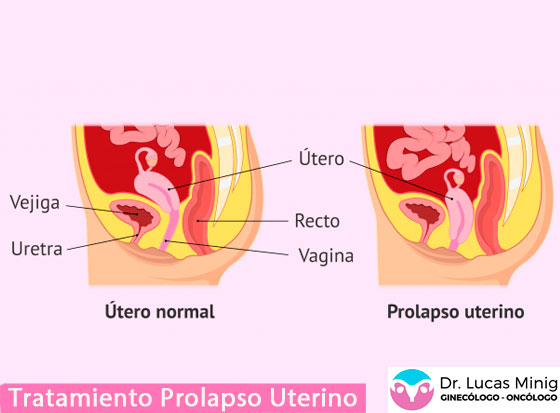Treatment For Pelvic Organ Prolapse and Urinary Incontinence
Pelvic organ prolapse (POP) is a condition commonly presented in women, most of the time during late adulthood and after multiple births, in which the uterus descends and exerts pressure on the vaginal area.
Also known as female genital prolapse, or complete genital prolapse. The issue frequently falls into the category of surgical pelvic prolapse treatment by Gynecology specialists in Spain.
This condition develops when the womb (uterus), and/or the bladder, and/or the rectum descend and exert pressure on the vaginal area.
Understand what a procedure for the effective treatment of pelvic organ prolapse entails with the following explanatory videos by Dr. Lucas Minig Gynecologist – Oncologist Specialist in Valencia, Spain.
We explain the treatment below.
Understanding Female Pelvic Organ Prolapse
Stress Urinary Incontinence in Women
Discover more about surgical options for pelvic organ prolapse that we perform in our clinic in Valencia, Spain.
Surgical Treatment for Pelvic Organ and/or Uterine prolapse
How Is Pelvic Organ Prolapse And Uterine Prolapse Treated?
Surgery should not be performed until symptoms caused by the prolapse are more significant than the risk of undergoing surgery. The specific type of surgery depends on:

There are some surgical procedures that can be performed without removing the uterus, such as sacroespinous fixation. This procedure involves the use of nearby ligaments to support the uterus. There are other procedures available.
Vaginal hysterectomy is commonly used to correct uterine prolapse. Any descent of the vaginal walls, the urethra, the bladder, or the rectum can also be surgically fixed on the same procedure.
Treatment is not necessary unless the symptoms cause discomfort.
Many women receive treatment when the uterus reaches the vaginal opening.
Lifestyle Changes To Manage Symptoms.
The following can help control your symptoms:

Vaginal Pessary
The doctor could recommend placing a rubber or plastic ring-shaped device, called a pessary, inside the vagina. This device holds the uterus in place.
The pessary can be used for either a short or a long time. The device adjusts to the vagina. Some pessaries resemble a diaphragm used for birth control.
Pessaries need to be cleaned regularly. Sometimes, cleansing by a doctor or nurse becomes necessary. Many women can be tought how to insert, clean, and remove the pessary.
Side effects of pessaries include:
Source: Medline Plus: National Library of Medicine United States
Talk To A Doctor About Pelvic Organ Prolapse or Uterine Prolapse
You can consult our medical center, directed by Doctor Lucas Minig, specialist in urinary incontinence and genital prolapse treatments in Spain, based in Valencia, find us here -> Av. del General Avilés, 90, 46015 València, Valencia.
Request assistance online: Online medical appointment
Request more information
Request a second medical opinion
Call Us on the phone: 679 112 179
Gynecologist Oncologist in Spain
Get to know Lucas Minig Training
See our Multidisciplinary Medical Team in Valencia
Recommendations after hospital discharge once the urine control or prolapse treatment has been carried out
How to care for surgical wounds after treatment for urinary incontinence or genital prolapse?
Frequently Asked Questions About Urinary Incontinence and Genital Prolapse
How to cure uterine prolapse without surgery?
Through a healthy lifestyle and home remedies we can obtain improvements and control urine and prolapse problems.
- Perform Kegel exercises to strengthen your pelvic muscles and support weakened fascia.
- Avoid constipation by consuming high-fiber foods and plenty of fluids.
- Avoid straining to have a bowel movement.
How do I know what type of prolapse I have?
Prolapse grades
- Grade 1 or mild: slight descent into the vagina.
- Grade 2 or moderate: the descent reaches the entrance of the vagina.
- Grade 3 or severe: the prolapse exceeds the entrance of the vagina, the woman touches or feels the bulge perfectly when walking, especially when making efforts.
How to recover from a prolapse?
They can be treated and reversed with pelvic floor exercises and a change in habits. For example, it is necessary to eat a balanced diet, eliminate tobacco, limit physical overexertion and perform exercises that do not aggravate the existing prolapse.
What can I do so that my urine does not come out?
Tips to control urine leakage
- Go to urinate regularly, without too many hours passing between one urination and the next.
- Avoid exciting drinks, such as coffee or tea.
- Do not run when you notice a strong desire to urinate. …
- Do not make physical overexertion.
Why does my urine leak?
Incontinence can occur for many reasons. For example, urinary tract infections, vaginal infection or irritation, constipation, and some medications that can cause short-term bladder control problems
Patient Testimonials Genital Prolapse and Urinary Incontinence Treatment in Spain
Doctor Lucas Minig Specialist in treating problems related to urinary incontinence and genital prolapse in Valencia, Spain
Contact Us
Leave us your data and consultation to offer you personalized medical advice
International Consultation
If you want remote medical care, you can consult
through the following links:
International Appointment
Online Consultation
Whatsapp: + 34 679 112 179


